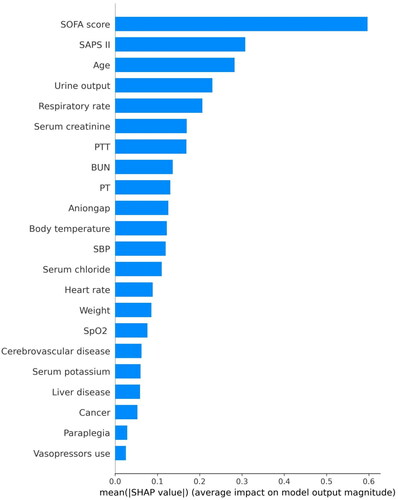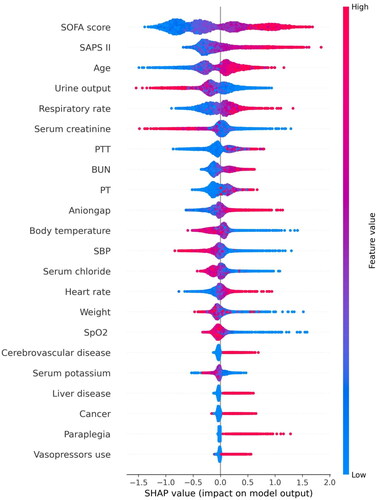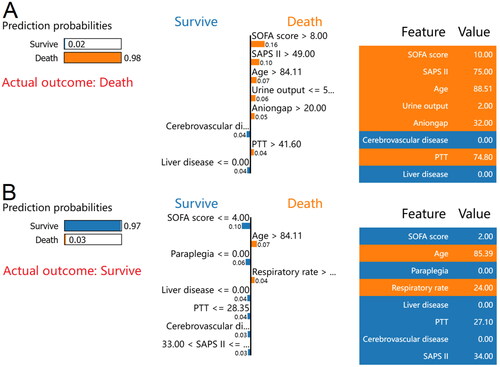Figures & data
Figure 1. The flowchart of patient selection.
Abbreviations: CHF: congestive heart failure, CKD: chronic kidney disease, MIMIC IV: Medical Information Mart for Intensive Care IV, ICU: intensive care unit.

Table 1. Demographic and clinical characteristics at baseline.
Figure 2. ROC Curves for predicting the incidence of in-hospital mortality with ML models and the traditional severity of illness scores.
A ROC curves of six ML models for predicting in-hospital mortality; B ROC curves for the traditional severity of illness scores predicting in-hospital mortality. Abbreviations: ROC: receiver operating characteristic, SVM: support vector machine, KNN, k-nearest neighbors, AUC: area under the curve, SOFA: sequential organ failure assessment, SAPS II: simplified acute physiology score II.

Table 2. Performance comparison of the six models in the testing set.
Figure 3. The important features derived from the XGBoost model.
Ranking of feature importance indicated by SHAP. The matrix plot depicts the importance of each covariate in the development of the final predictive model.
Abbreviations: SHAP: SHapley Additive explanation, SOFA: sequential organ failure assessment, SAPS II: simplified acute physiology score II, PTT: partial thromboplastin time, BUN: blood urea nitrogen, PT: prothrombin time, SpO2: oxygen saturation, MAP: mean arterial pressure.

Figure 4. SHAP summary plot of the features of the XGBoost model.
The higher the SHAP value of a feature, the higher the probability of death development. Each line represents a feature, and the abscissa is the SHAP value. Red dots represent higher feature values, and blue dots represent lower feature values.
Abbreviations: SHAP: SHapley Additive explanation, SOFA: sequential organ failure assessment, SAPS II: simplified acute physiology score II, PTT: partial thromboplastin time, BUN: blood urea nitrogen, PT: prothrombin time, SpO2: oxygen saturation, MAP: mean arterial pressure.

Figure 5. SHAP dependence plot of the XGBoost model.
SHAP values for specific features exceed zero, representing an increased risk of death development.
Abbreviations: SHAP: Shapley Additive explanation, SOFA: sequential organ failure assessment, SAPS II: simplified acute physiology score II.

Figure 6. LIME algorithm for explaining individual’s prediction results.
Screenshot of the death prognosis for critically ill patients with CHF combined with CKD. (A) Utilizing the LIME method, show a death case. (B) Present a case of survival using the LIME method. The left portion of the picture depicts expected LIME findings. The center section lists, from highest to lowest, the eight variables that had the greatest impact on survival or death. The length of the bar for each feature reflects the weight of that feature in the prediction. A longer bar represents a characteristic that contributes more to survival or mortality. The right panel displays the crucial values of these eight factors at which they had the greatest influence on survival or death.
Abbreviations: LIME: Local Interpretable Model-Agnostic Explanations, CHF: congestive heart failure, CKD: chronic kidney disease, SOFA: sequential organ failure assessment, SAPS II: simplified acute physiology score II, PTT: partial thromboplastin time.

Supplemental Material
Download PDF (464.5 KB)Data availability statement
The datasets presented in the current study are available in the MIMIC IV database (https://physionet.org/content/mimiciv/1.0/).
